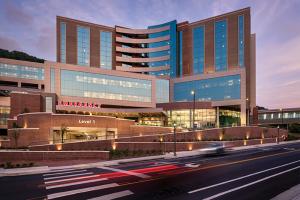New hospital helps support total community transformation

The 316-bed Glick Center replacement hospital is helping to breathe new life into its neighborhood.
Image courtesy of HGA; Nic Lehoux Architectural Photography
The nation’s first EcoDistrict anchored by a health care system continued to evolve with the opening of The Glick Center, part of Cleveland’s MetroHealth System, in October 2022.
EcoDistricts is an organization that since 2014 has been promoting a new planning model of urban development it calls The Protocol.
The model helps to guide city planners in creating collaborative, holistic, just, sustainable and resilient neighborhoods, of which health care is a vital part. The model centers on a number of community-based factors, such as the relationship between health outcomes and poverty, inadequate neighborhood and community networks, remoteness of safe green spaces and more.
The Glick Center helps to further cement MetroHealth’s standing as an integral part of its EcoDistrict and also represents the newest project added to the system’s $946-million transformation of its main campus in the Clark-Fulton neighborhood.
With the opening of the hospital, MetroHealth is one step closer to its goal of “not only creating healthier patients and employees but also a healthier community,” says Gregory Zucca, executive director of community transformation and real estate holdings at MetroHealth. “The EcoDistrict process really helped us to look at some broader ways the hospital could help to uplift the community that we serve,” he says.
To address these factors, The Glick Center combines cutting-edge technology and infrastructure with modern design to improve overall efficiency while also creating spaces that promote comfort and healing.
The 767,000-square-foot building, which is aiming for LEED certification, is nationally recognized for environmental sustainability through awards from Practice Greenhealth. A new, more energy efficient central utility plant is helping to reduce the health system’s carbon footprint. With The Glick Center operational, the health system expects to realize a 31% increase in energy efficiency, according to Zucca.
In addition, the health system is seeking to expand other environmentally friendly practices. For example, the hospital is relying on retention basins for water runoff.
“In Cleveland, we have a combined storm and sanitary sewer system. So, by controlling that runoff on-site, it helps to reduce contaminants that are going into the lake,” Zucca says.
To deliver on the “Hospital in a Park” vision set out by MetroHealth nearly a decade ago as part of its campus transformation, The Glick Center is surrounded by 3 acres of green space, which will grow to become a larger park once retired facilities are demolished in 2024. Overall, about half of the campus’ 52 acres will be green space.
With this proliferation of green space, the hospital sits at the center of a revitalization effort that zeros in on issues such as environmental equity, which is one of many social drivers of health. It also means the facilities management department is being called on to address accessibility issues.
For instance, health care facilities managers had to think about “accessibility of the buildings,” Zucca says. “If people are taking public transportation, how do they transition from public transportation to the campus?”
Prior to the green space being added, no sidewalk existed connecting the bus stop to the main entryway. MetroHealth demolished two vacant abandoned buildings and a surface parking lot that was completely fenced in to construct a sidewalk from the bus stop to the front door.
The design of the hospital’s interior also supports the community.
The inclusion of well-furnished family spaces enables loved ones to be present during patient stays. The building includes kitchenettes equipped with microwaves, making it possible to bring home-cooked food in and reheat it. The family resource center allows loved ones to visit the hospital and prepare cultural foods for ailing family members staying at the hospital.
In addition, the building houses more than 1,008 pieces of unique art, including 86 newly commissioned murals and photography. Over 74% of the artwork displayed in The Glick Center was created by local artists.
“We really want to make it as comfortable of an environment as possible and to reduce stress levels as much as possible,” Zucca says. “In addition to having lots of new artwork installed in the building, the general overall aesthetic is very welcoming and inviting.”
MetroHealth’s mission to reduce unjust health and socioeconomic disparities in the community and achieve the EcoDistrict designation required working with a variety of partners, including the local councilwoman, the Metro West Community Development Organization, Cleveland Foundation and resident ambassador cohorts.




